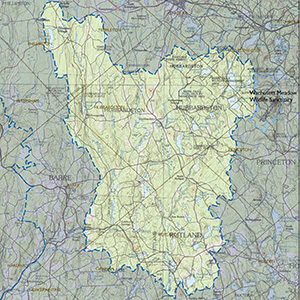Important Bird Area Sites in Massachusetts
Important Bird Area: Ware River Watershed
Site Summary
Nominated By
John Liller, Mark Lynch, Sheila Carroll
Size
62,270 acres
Towns and Counties
Barre, Hubbardston, Oakham, Rutland; Worcester
Ownership
Department of Conservation and Recreation, Army Corps of Engineers, private
Major Habitats
northern hardwoods forest, oak-conifer forest, early successional shrubland, emergent freshwater wetland, palustrine woodland swamp, lake/pond, river/stream, hawk-watching site, migratory stopover site
Land Use
hunting/fishing, other recreation or tourism, forestry, water supply, utility/right-of-way
IBA Criteria
- Category 4: Sites important for long-term research and/or monitoring projects that contribute substantially to ornithology, bird conservation, and/or education.
- Category 5: Sites containing assemblages of species characteristic of a representative, rare, threatened, or unique habitat within the state or region.
Site Description
This IBA consists of mixed forest, with sizable stands of conifer and hemlock, traversing dirt and paved roads. This IBA also includes a significant part of the DCR Ware River Watershed. Included within this area are Barre Falls Dam, an Army Corps of Engineers (ACOE) flood-control project, Rutland State Park, and a wildlife management area. The open, scrubby aspect of a former prison site is good habitat for the Warbling Vireo, Prairie Warbler, Eastern Towhee, and Brown Thrasher. The latter is a species very uncommon in the rest of the area. In late November into December, flocks of Common Redpolls have been found here, and Northern Shrikes have been spotted. A large area of Red Pine that once stood in the vicinity of the Prison Camp has been cleared away by the DCR (ca.1980s), and several large fields are now present in this area. Two branches of the Ware River flow through the parcel, and these areas have numerous woody, shrubby marshes along the banks. There are several small ponds in the southeastern section.
Current Conservation Status
This parcel is managed by the Department of Conservation and Recreation (DCR) as part of its ongoing watershed management. Because of that, various areas are periodically subject to cutting and clearing. The effects of this cutting and clearing on bird populations is not clear, but is currently being monitored. The cutting increases habitat for cowbirds and at least locally degrades habitat. Though dirt bikes and ATVs are banned, they are still present in different areas because enforcement is difficult. People also illegally camp in spots, and the danger from fires set by these people and other vandals is always great. The stands of hemlock are important for breeding populations of Blackburnian, Magnolia, and Black-throated Green Warblers, as well as Evening Grosbeaks and Golden-crowned Kinglets. Invasion by the Woolly Adelgid in this area would be devastating to breeding birds. The IBA is frequented by many hikers, bikers, horseback riders and drivers of vehicles who find the many dirt roads inviting.
Ornithological Significance
The Ware River IBA hosts significant breeding populations of a wide variety of neotropical migrants. Breeding Bird Survey (BBS) and migration counts for over a decade in a much smaller area within the designated IBA have revealed large numbers of breeding thrushes, vireos, warblers, and tanagers. The area is also significant as a major site for passerine migration, and large numbers of migrant land birds pass through, feed, and stage in the forest and fields within this IBA. Uncommon or interesting Massachusetts species that have been noted during breeding season include: Wood Duck, Hooded Merganser, American Bittern, Northern Goshawk, Red-shouldered Hawk, Northern Saw-whet Owl, Barred Owl, Black-billed and Yellow-billed Cuckoos, Common Raven, Golden-crowned Kinglet, 19 species of warblers, 4 species of vireo, and Evening Grosbeak. An official BBS route is established within the parcel and has been run by DCR staff for several years since 1993 (see Bird Observer). In the past few years an additional standard route along two roads north and west of the parcel was established that they have been surveying. In recent years, a hawk-watch site has been established at Barre Falls Dam and has recorded significant numbers of migrant raptors. At least one Great Blue Heron rookery is located on the parcel. A Boreal Chickadee, "winter finches", and a Northern Shrike have all been found several times in winter.
Other Flora or Fauna of Significance
A wide variety of vertebrates and invertebrates have been found within this IBA. Mammals include all those that one would expect in a large wooded parcel with wetlands: Beaver, Gapper's Redback Vole, Muskrat, Meadow Jumping Mouse, Coyote, Fisher, Ermine, Mink, River Otter. Moose have been seen with increasing frequency in recent years. Butterflies are present in a wide variety, and butterfly reports from the IBA are included. Notable among the species present is a good population of Harris' Checkerspots. Wildflowers species include: Common Trillium, Nodding Ladies Tresses and nice patches of Bottle Gentian among many others. A large area of Rose Pogonia is found under the bridge at Barre Falls Dam.
Data Sources
Data from the area has been recorded in BBS surveys, Eastern Massachusetts Hawk Watch surveys, and journals such as Bird Observer and The Chickadee.
All "personal observations" have been sent to various journals for publication.
M. Lynch. 2002. "Where-to-find" birds in Western Massachusetts.




